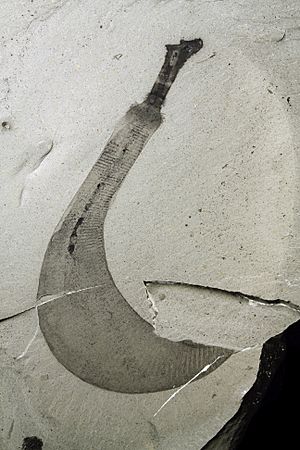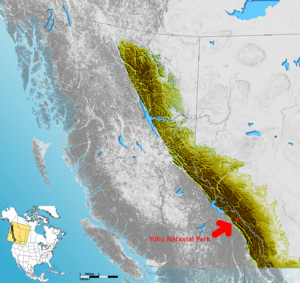Burgess Shale facts for kids
Quick facts for kids Burgess ShaleStratigraphic range: Miaolingian ~508Ma |
|
|---|---|

Ottoia, a soft-bodied worm, common in the Burgess Shale. (From Smith et al. 2015)
|
|
| Type | Geological formation |
| Unit of | Stephen Formation |
| Thickness | 161 meters (528 ft) |
| Lithology | |
| Primary | Shale |
| Location | |
| Coordinates | 51°26′N 116°28′W / 51.433°N 116.467°W |
| Region | Yoho National Park and Kootenay National Park |
| Country | Canada |
| Type section | |
| Named for | Burgess Pass |
| Named by | Charles Doolittle Walcott, 1911 |
 Map highlighting Yoho National Park in red |
|
The Burgess Shale Formation is a famous place in the Rocky Mountains of British Columbia, Canada. It's known for having some of the best fossils ever found. What makes it special is that it has fossils of animals' soft parts, like skin and organs, which usually don't last.
These fossils are super old, about 505 million years old! They come from a time called the Middle Cambrian period. This makes the Burgess Shale one of the earliest places where soft-bodied fossils have been found.
The rocks here are a type of black shale. You can find them in many spots near the town of Field, which is inside Yoho National Park.
Contents
Discovery of the Burgess Shale
The Burgess Shale was found by a palaeontologist named Charles Doolittle Walcott. He discovered it in 1909 while he was doing fieldwork.
Walcott came back in 1910 with his sons. They set up a special digging site, called a quarry, on the side of Fossil Ridge. He realized that the fossils were of soft-bodied animals. Many of these creatures were completely new to science.
Because of these amazing discoveries, Walcott returned to the quarry almost every year. He kept digging until 1924. By then, he had collected more than 65,000 fossil samples!
Studying the Fossils
Describing all the fossils was a huge job. Walcott worked on it until he passed away in 1927. Scientists are still studying these fossils today, even in the 21st century.
At first, Walcott tried to fit all the new fossils into animal groups that were already known. Because of this, many people thought the fossils were just interesting oddities.
It wasn't until 1962 that a scientist named Alberto Simonetta took a fresh look at the fossils. His work helped other scientists see that Walcott had only just begun to understand how important the Burgess Shale was.
New Discoveries
Later, another digging site was opened in the same rock formation. A careful new study of the Burgess Shale showed that the animals found there were much more varied and unusual than Walcott had thought.
Today, the Royal Ontario Museum has the biggest collection of Burgess Shale fossils. They have over 150,000 specimens! Many of the animals found there had very strange body parts. They looked only a little bit like other known animals.
For example, there's Opabinia, which had five eyes and a snout like a vacuum cleaner hose. Other strange creatures include Nectocaris and Hallucigenia. Hallucigenia was even first put back together upside down, walking on its spines!
World Heritage Site
The Burgess Shale was named a UNESCO World Heritage Site in 1980. This means it's a very important place for everyone in the world to protect.
In 1984, it became part of the larger Canada Rocky Mountain Parks World Heritage Site.
Related pages
Images for kids
-
The first complete Anomalocaris fossil ever found.
-
A Satellite image showing the area of the Burgess Shale.
See also
 In Spanish: Esquisto de Burgess para niños
In Spanish: Esquisto de Burgess para niños




